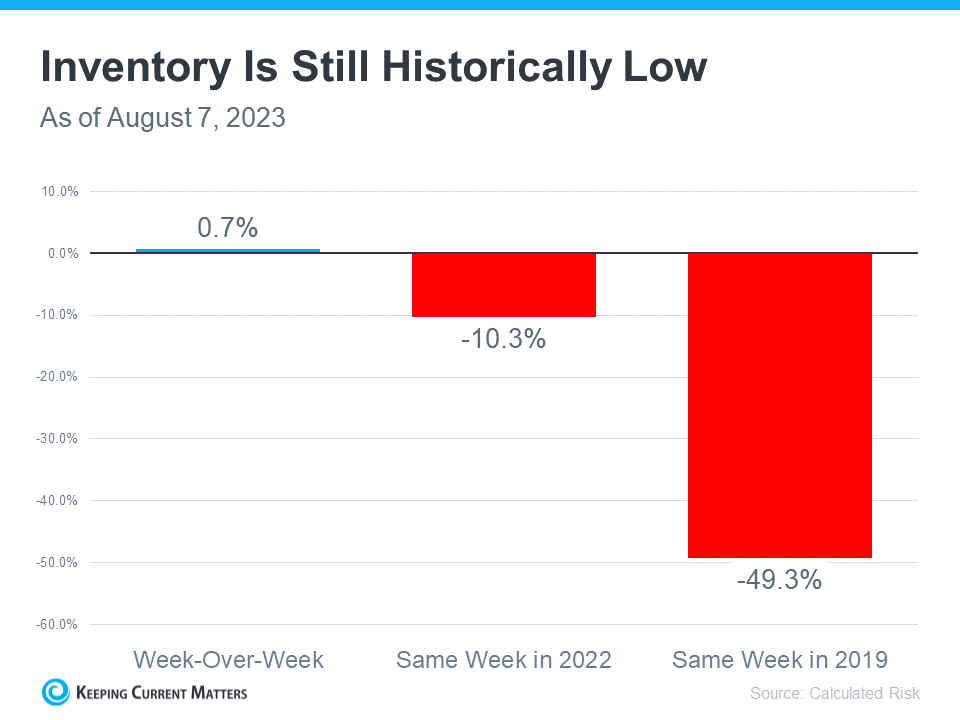Realty Executives Midwest

Wondering if it still makes sense to sell your house right now? The short answer is, yes. Especially if you consider how few homes there are for sale today.
You may have heard inventory is low right now, but you may not fully realize just how low or why that’s a perk when you go to sell your house. This graph from Calculated Risk can help put that into perspective:
 As the graph shows, while housing inventory did grow slightly week-over-week (shown in the blue bar), overall supply is still low (shown in the red bars). Compared to the same week last year, supply is down roughly 10% – and it was already considered low at that time. But, if you look further back, you’ll see inventory is down even more significantly.
As the graph shows, while housing inventory did grow slightly week-over-week (shown in the blue bar), overall supply is still low (shown in the red bars). Compared to the same week last year, supply is down roughly 10% – and it was already considered low at that time. But, if you look further back, you’ll see inventory is down even more significantly.
To gauge just how far off from normal today’s inventory is, let’s compare right now to 2019 (the last normal year in the market). When you compare the same week this year with the matching week in 2019, supply is about 50% lower. That means there are half the homes for sale now than there’d usually be.
The key takeaway? We’re still nowhere near what’s considered a balanced market. There’s plenty of demand for your house because there just aren’t enough homes to go around. As Lawrence Yun, Chief Economist at the National Association of Realtors (NAR), explains:
“There are simply not enough homes for sale. The market can easily absorb a doubling of inventory.”
So, if you want to list your house, know that there’s only about half the inventory there’d usually be in a more normal year. That means your house will be in the spotlight if you sell now and you may see multiple offers and a fast home sale.
With the number of homes for sale roughly half of what there’d usually be in a more normal year, you can rest assured there’s demand for your house. If you want to sell, connect with a local real estate agent now so your house can shine above the rest while inventory is so low.
Source: Keeping Current Matters
Realty Executives Midwest
1310 Plainfield Rd. Ste 2 | Darien, IL 60561
Office: 630-969-8880
E-Mail: experts@realtyexecutives.com
Plenty of people are still moving these days. And if you’re thinking of making a move yourself, you may be considering the inventory and affordability challenges in the housing market and wondering what you can do to help offset those. A new report from Gravy Analytics provides insight into where people are searching for homes and what they’re prioritizing most right now. That information could help you plan your own move.

One big factor motivating where buyers are going is affordability and that’s no big surprise. People are relocating to areas that have less expensive housing options. As a result, small cities are thriving. Hannah Jones, Economics Data Analyst at Realtor.com, summarizes why:
“Affordability is still very much front and center . . . a lot of what’s available is outside of the price range of many buyers. . . . so they look elsewhere for a little more bang for the buck.”
The takeaway for you? If you’re having trouble finding a home that fits your budget, it may help to browse other, more affordable locations nearby.
And, if you’re already expanding your search radius, you may be able to include a location that features your favorite type of destination, like a suburb near the beach or a mountain town. Data shows many other homeowners are making that type of move a priority today. According to the same report from Gravy Analytics:
“Whether it’s the opportunity to enjoy more weekend hikes in the mountains or to wake up to a lakeside sunrise, people are moving to areas that were once thought of as vacation spots.”
Even with today’s home prices and mortgage rates, here’s why a move like this could be possible for you. If you’re already a homeowner, the equity you’ll get when you sell your current house can help fuel that move and give you the down payment you’d need for your dream home.
Ongoing remote work is another major factor in where people are moving. A recent report from the McKinsey Global Institute says this about recent movement patterns:
“Many of these moves happened because employees untethered from their daily commutes began to care less about how far they lived from the office.”
If you’re a remote or hybrid worker, you don’t have to live in the same city, or sometimes even the same state, as your job. That means you can prioritize other things, like being closer to loved ones, when buying a home.
In fact, the same McKinsey Global Institute report notes for people who moved during the pandemic, 55% reported moving farther from the office. And since remote work is still a popular choice today, homebuyers will likely continue to take advantage of that flexibility.
Lots of people are still moving today. If you want help navigating today’s inventory or affordability challenges, and expert advice to help you find your ideal home, connect with a trusted real estate agent.

When it comes to selling your house, you want three things: to sell it for the most money you can, to do it in a certain amount of time, and to do all of that with the fewest hassles. And, while the current housing market is generally favorable to sellers due to today’s limited housing supply, there are still factors that can cause delays or even prevent a house from selling.
If you’re having trouble getting your house to sell in today’s sellers’ market, here are a few things to think about.
One of the biggest mistakes you can make as a seller is limiting the days and times when buyers can view your home. In any market, if you want to maximize the sale of your house, you can’t limit potential buyers’ ability to view it. Remember, minimal access equals minimal exposure.
In some cases, some of the most motivated buyers may come from outside of your local area. Because they’re traveling, they might not have the luxury to adjust their schedules when faced with limited options to tour your house, so make it available as much as possible.
Pricing is a critical factor that can significantly impact your home sale. While it’s tempting to push the price higher to try to maximize your profit, overpricing can deter potential buyers and lead to your home sitting on the market longer.
Jeff Tucker, Senior Economist at Zillow, notes:
“. . . sellers who price and market their home competitively shouldn’t have a problem finding a buyer.”
Not to mention, buyers today have access to a number of tools and resources to view available homes in your area. If your house is priced unreasonably high compared to similar homes, it may drive potential buyers away. Listen to the feedback your agent is getting at open houses and showings. If the feedback is consistent, it may be time to re-evaluate and potentially lower the price.
When selling your house, the old saying “you never get a second chance to make a first impression” matters. Putting in the work on the exterior of your home is just as important as what you stage inside. Freshen up your landscaping to improve your home’s curb appeal so you can make an impact upfront. As an article from Investopedia says:
“Curb-appeal projects make the property look good as soon as prospective buyers arrive. While these projects may not add a considerable amount of monetary value, they will help your home sell faster—and you can do a lot of the work yourself to save money and time.”
But don’t let that stop at the front door. By removing personal items and reducing clutter inside, you give buyers more freedom to picture themselves in the home. Additionally, a new coat of paint or cleaning the floors can go a long way to freshening up a room.
For all of these things, lean on your real estate agent for expert advice based on your unique situation and feedback you get from buyers throughout the process.
If your house isn’t getting the attention you feel it deserves and isn’t selling in the timeframe you wanted, it’s time to ask your trusted real estate agent for advice on what you may need to revisit or change in your approach. To get those expert insights, connect with a real estate professional.
Source: Keeping Current Matters
Realty Executives Midwest
1310 Plainfield Rd. Ste 2 | Darien, IL 60561
Office: 630-969-8880
E-Mail: experts@realtyexecutives.com

You may have heard some people say it’s better to rent than buy a home right now. But, even today, there are lots of good reasons to become a homeowner. One of them is that owning a home is typically viewed as a good long-term investment that helps your net worth grow over time.
You may be surprised to learn homeowners across various income levels have a much higher net worth than renters who make the same amount. Data from First American helps illustrate this point (see graph below):
What makes wealth so much higher for homeowners? A recent article from Realtor.com says:
“Homeownership has long been tied to building wealth—and for good reason. Instead of throwing rent money out the window each month, owning a home allows you to build home equity. And over time, equity can turn your mortgage debt into a sizeable asset.”
Basically, the wealth you accumulate when you own a home has a lot to do with equity. As a homeowner, equity is built up as you pay down your loan and as home prices appreciate over time. Mark Fleming, Chief Economist at First American, explains how this same benefit isn’t true for renters in a recent podcast:
“Renters as non-homeowners gain no wealth benefit as home prices rise. That wealth actually accrues to the landlord.”
Before you decide to sign another rental agreement, now is a good time to think about whether it would be better for you to buy a home instead. The best way to figure out what makes sense for you is to have a conversation with a real estate expert you trust. That professional can talk you through the benefits that come with owning to determine if that’s the right next step for you.
If you're not sure whether to keep renting or to buy a home, know that owning a home, no matter how much money you make, can help build your wealth. Connect with a local real estate agent to get started on the path to homeownership.
Source: Keeping Current Matters
Realty Executives Midwest
1310 Plainfield Rd. Ste 2 | Darien, IL 60561
Office: 630-969-8880
E-Mail: experts@realtyexecutives.com
A clean kitchen is crucial for maintaining a healthy environment and ensuring safe and delicious food. However, finding the time or desire to deep clean can be challenging. The good news is that you do not need multiple days and hours to achieve a sparkling-clean kitchen. With expert advice and handy tips, you can deep clean your kitchen in just one day. This article provides effective techniques and tricks to tackle tough grime and grease, transforming your kitchen into a spotless and inviting space.

Why Deep Cleaning Your Kitchen Matters
Deep cleaning your kitchen offers several benefits. It maintains a hygienic food storage and preparation environment, prevents pests and insects, and enhances overall appearance and functionality. Additionally, it reduces the spread of germs and bacteria, especially during cold and flu seasons.
Essential Supplies for Deep Cleaning Your Kitchen
To speed things along, it is best to prepare for your deep cleaning job. Before you start, gather the necessary supplies:
Step-by-Step Guide to Efficiently Deep Clean Your Kitchen
Now let us dive into a step-by-step guide to efficiently deep cleaning your kitchen in just one day:
Step 1: Declutter and Organize
Begin by removing all items from countertops, cabinets, and drawers. Sort and discard expired, damaged, or unnecessary items. Organize the remaining items into categories for easy access. By starting with cleared cabinets and counters, it will be easy to spot crumbs, dust, and other particles that you will want to clean up.
Step 2: Clean Your Appliances
Start with the oven and microwave- two appliances that are frequently skipped during quick kitchen cleanups. Apply an oven cleaner and let it sit, then wipe down the inside with a damp cloth. If your oven has an oven cleaning setting, we recommend running this cycle before using the cleaning products. This high-heat setting will help burn off a good portion of the particles inside the oven, meaning you will likely need less oven cleaner.

Clean the microwave by mixing water and vinegar in a small bowl and microwaving it for a few minutes. The steam will help break down the hard-to-clean grime. Next, use a cloth to wipe down the inside, including the glass tray. If you do not have vinegar on hand, lemon or baking soda can easily be substituted.
Step 3: Clean Cabinets and Countertops
Wipe down countertops and the inside of cabinets with an all-purpose cleaner. If you run into particularly stubborn stains, grime, or oil, you may need to use a degreaser and scrubbing brush. We recommend testing a small, discreet area of your counter or cabinet when using strong cleaning materials to make sure it does not damage or bleach it. Finish by wiping everything down with a damp cloth so there is no remaining residue.
Step 4: Clean Your Sink
There are several ways to tackle one of the dirtiest areas of the home: the sink. The most popular method is to fill the sink with warm water and add a few small capfuls of bleach. Let the bleach water sit for several minutes, drain the sink, and then wipe it down with a microfiber cloth. As an alternative to bleach, you can mix warm water, baking soda, and white vinegar. Regardless of the products you use, remember to address the faucet and the faucet handles- they are often just as dirty as the sink!
Step 5: Clean Your Floors
Begin by sweeping and vacuuming the floors to remove dirt and debris. Follow up with a mop or steam cleaner for a thorough clean. If you have tile floors with stained grout, use a grout cleaner to restore its appearance.

For the sake of time, remember to finish your deep clean with your floors! Cleaning appliances, counters, and cabinets mean that debris falls on the floor even with the best efforts to contain it. Avoiding sweeping and vacuuming multiple times by getting it all in one swoop at the end.
Tips for Cleaning Difficult Areas
Here are some tips for effectively cleaning hard-to-reach places:
Maintaining a Clean Kitchen
You do not want your deep cleaning efforts to go to waste. After deep cleaning, establish a routine for maintaining cleanliness:
Benefits of a Clean Kitchen
Maintaining a clean kitchen provides several benefits:
Deep cleaning your kitchen does not have to be overwhelming. With these expert tips, you can achieve a sparkling-clean kitchen in just one day. Remember to declutter, clean appliances, cabinets, countertops, sinks, and floors, and use the appropriate supplies for challenging areas. Maintaining a clean kitchen will create a healthy and inviting space for cooking and entertaining.